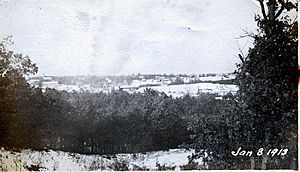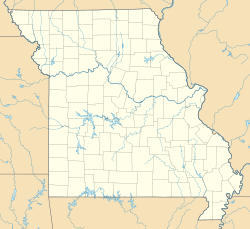Lingo, Missouri facts for kids
Quick facts for kids
Lingo, Missouri
|
|
|---|---|

View of Lingo from the east side, January 8, 1913.
|
|
| Country | United States |
| State | Missouri |
| County | Macon |
Lingo is a small community in Macon County, Missouri. It is located about 20 miles west of the city of Macon. This place has a cool history, especially with coal mining. It grew and changed a lot over time.
Contents
Discovering Lingo, Missouri
How Lingo Started
Lingo was officially planned out in 1873. It was named after an early settler, Samuel Sanders Lingo. He was born in South Carolina in 1805. Samuel Lingo was an important person in Macon County. He served as a county judge for 25 years.
Before it was called Lingo, the area was known as "Peabody's Woodyard." A man named Colonel Peabody used to stack wood there. He sold this wood to the railroad. Lingo is located north of U.S. Route 36. It sits between Brush Creek and the Mussel Fork of the Chariton River.
Mining Days in Lingo
Lingo's history with coal mining began in 1873. This was after people found low-grade coal nearby. Two brothers, George and Thomas Jobson, started the first coal mine. They worked for the Hannibal and St. Joseph Railroad.
Miners from Bohemia in Europe were hired to dig the coal. They were used to this type of mining work. Because of the mines, Lingo's population grew a lot. At one point, between 1,500 and 2,000 people lived there.
A Changing Town
In 1892, a big meat company called Armour and Company bought the town. During their ownership, the workers went on strike. To show their support for the strike, all the houses in Lingo were painted yellow.
Later, coal was not the main source of power anymore. People started using oil-burning engines more often. Because of this, the coal mine in Lingo closed down. Many houses were moved to other towns by their owners. The railroad also moved the train station to a different town.
Lingo Today
In 1973, Lingo celebrated its 100th anniversary. There was a weekend of gatherings and events. News about the celebration even appeared in the Kansas City newspapers.
Today, you can still see parts of the old mine. You might spot them when you cross the train tracks. Only about 15 to 20 people live in Lingo now. But many mailboxes still show the names of families with Bohemian ancestors. In the 1800s, Lingo had about twenty streets. Now, only two of the original streets remain: Main and Lewis.



